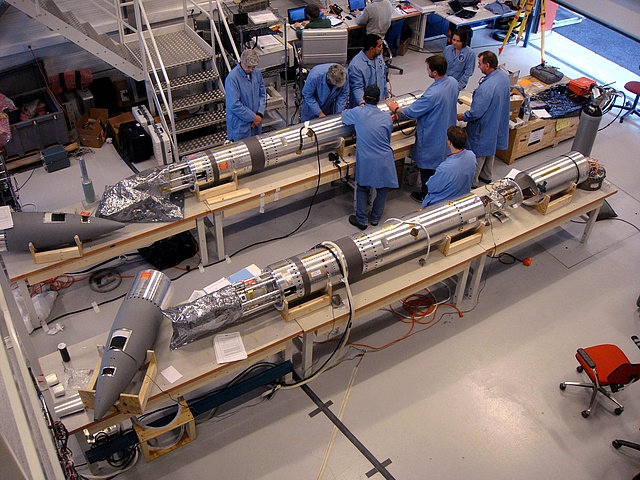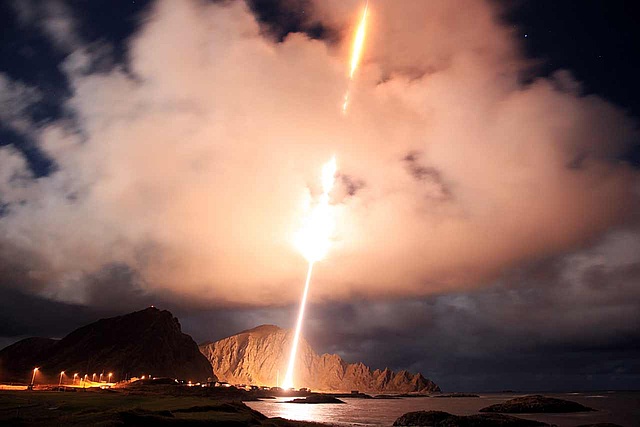WADIS CHAMPS
Electron Scavenging in the Mesosphere
FWF Project 23100
The project provided funding for participation in a total of four rocket flights, all launched from the Norwegian Andøya Space Center. The launch of two sounding rockets each in two campaigns, was foreseen, namely WADIS (with participants from Germany, Sweden and Austria) and CHAMPS (USA, Austria). The flights took place between 2011 and 2015. .
Electron Scavenging in the Mesosphere FWF Project 23100 The project provided funding for participation in a total of four rocket flights, all launched from the Norwegian Andøya Space Center. The launch of two sounding rockets each in two campaigns, was foreseen, namely WADIS (with participants from Germany, Sweden and Austria) and CHAMPS (USA, Austria). The flights took place between 2011 and 2015.
Abstract
The free electrons in the ionosphere are formed by ionisation by various processes such as by solar UV, solar X-rays, cosmic rays or energetic particles originating in the solar wind. The reverse reaction which limits the fraction of the atmosphere which is ionised, is either recombination by which the original neutral molecules are restored, or attachment to neutrals, including aerosols. These negatively charged particles thus formed in a further stage recombine with positive ions and lead to the original neutral atmosphere or indeed produce atmospheric trace constituents. The attachment process of electrons to the most abundant atmospheric constituents is fairly well understood from laboratory measurements, but observations in the real atmosphere show that the attachment of electrons ("scavenging") varies much more than could reasonably be expected due to any uncertainty of the laboratory data or the assumptions made concerning the background atmosphere. The most likely explanation for this large scatter is that attachment of free electrons does not only occur with molecules, but - notably in the mesosphere - with ablated meteorites which are theoretically expected and experimentally known to abound at these altitudes, but whose number density varies erratically. Most of the hitherto available data concerning night-time electron scavenging were obtained from rocket flights without associated measurements of parameters expected to be relevant to test the concept of electron attachment to meteoric smoke particles. Four sounding rockets were launched in three campaigns carrying instruments that are very relevant to test the hypotheses by which night-time electron loss in the mesosphere can be explained. The prime goals of these campaigns was to study the dynamics and energy balance of the mesosphere, and to establish the size and height distribution of meteoric dust particles. The inclusion of the Austrian plasma diagnostic instruments in these four payloads is mutually beneficial, i.e. on the one hand crucial for the prime objectives of the two payload types, and on the other hand the data on atomic oxygen, solar Lyman-α flux and meteor dust distribution contribute importantly towards the understanding the highly variable loss of free electrons.
Two of the four sounding rockets were launched in October 2011 from the Andøya (69°N). The two CHAMPS payloads coded 41.094 and 41.093 were launched by NASA on October 11th and 13th, under night- and day-time conditions, respectively. All instruments performed as expected and preliminary results were presented by the Principal Investigator Dr. S. Robertson during the Fall Meeting of the American Geophysical Union in San Francisco in December of the same year. Three peer-reviewed papers have since been published using the CHAMPS data, but results were also presented at conferences and published in the respective proceedings. Of the two WADIS flights one took place in daylight (June 27th, 2013), the other in full darkness (March 5th, 2015). The results of the various instruments have been processed by the experimenters, but a meeting to plan joint publications is only scheduled for late February 2016.

